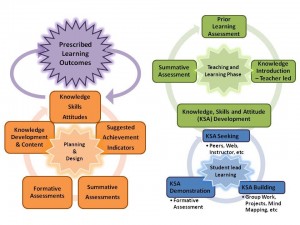
OLTD Learning Outcome:
- Demonstrate basic competency with design and implementation within a variety of online learning environments and tools
Evidence to Support Outcome:
Reflection to Support Evidence:
In September 2013, as part of OLTD 501, I created an instructional design model. The model is a visual representation of my personal model of instructional design, and is based on many different theories of online learning explained in the rationale section of the document. The visual element was created using Microsoft PowerPoint 2007 and the available SmartArt tool.
Although my evidence does not speak directly to the implementation piece of the learning outcome, it does speak to the design side of the outcome. In the process of creating my instructional design model, I learned about different ideas around online learning design. Specifically, I investigated the theories of Wedemeyer, Piaget, and Carroll; as well as the ASSURE model. Through my investigations I was able to develop my personal design model by adapting pieces from each theorist. Due to the fact I had to read and understand the material before being able to adapt it, my overall knowledge of different theories and models for online learning has increased. I feel having a broad knowledge base is important when I implement my ideas, as I will need to draw from it in order to adapt to changing contexts. Throughout this process I realized how different designing for the online context is from designing for a face-to-face context. Although at first there seems to be more freedom in designing for online, there are very specific challenges (such as asynchronous delivery) that must be carefully considered.
In the process of creating this piece of evidence, I also developed my skills as a visual designer. I found it much easier to describe my instructional design model in words then to create a visual representation of it. I feel that creating meaningful visual representations will be important in an online environment in order to support all types of learners, so I am glad for the chance to practice that skill.
This outcome is important in an instructional context because the process of designing for an online context will help create a better experience for both the students and the instructor. Specific to the BC context, the completion rates for online programs is low, and careful design with the challenges students face in the online classroom in mind may help to improve the chance for successful completion. The model I created is also adaptable to different levels of student-teacher contact, and I hope that when I have an opportunity to implement it my practice will be improved.
Overall, learning about design and implementation of learning environments and tools is critical for DL teacher success. The process of design and implementation can change depending on the specific DL context, so knowing where to seek further knowledge, or having a large knowledge base to draw from, is critical. Instructional design can take many forms, and I hope that throughout the program I have the opportunity to continue to learn more about implementing design, as well as designing using specific tools.